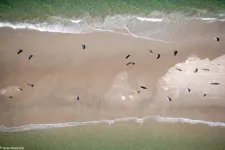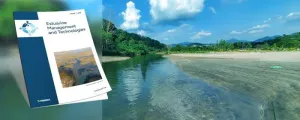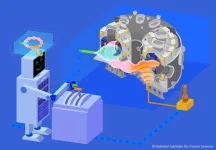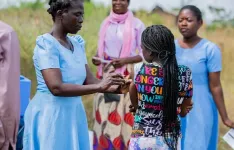(Press-News.org) Early in the pandemic, clinicians noticed that certain immunocompromised patients were experiencing persistent SARS-CoV-2 infections, some lasting weeks to months at a time.
This raised concerns that one of these cases could be the source of an emerging viral variant that has benefited from an extended battle with the immune system.
A prospective study published in the journal Lancet Microbe provides more clarity on which patient populations are at higher risk for prolonged infections —and hints that this fear is likely unwarranted.
The study, led by Adam Lauring, M.D., Ph.D., of the Division of Infectious Disease at Michigan Medicine, is part of the larger CDC-sponsored IVY Network study directed out of Vanderbilt University.
The collaborative team followed 150 immunocompromised patients with COVID infections from five United States health systems in 2022.
Each patient was surveyed and tested using nasal swabs collected from onset of SARS-CoV-2 infection until they tested negative.
“We were specifically looking at who was at risk for prolonged infection, such that they never cleared the virus,” said Lauring.
Immunocompromising conditions
The study participants had a diverse set of immunocompromising conditions, ranging from people with B-cell cancers or receiving anti-B cell therapy; solid organ or stem cell transplant recipients; people living with AIDS; and those with non-B cell cancers and autoimmune or autoinflammatory conditions.
The team found that just 25% of patients tested positive using the gold standard, highly sensitive PCR test for 21 days or longer after onset of illness.
Only 8% tested positive for live virus for 21 days or longer. The median time to last positive test overall was nine days.
“In contrast to a lot of case reports, we were finding that very few people had prolonged infection,” said Lauring.
Specifically, people living with AIDS and those with B-cell cancers, like certain leukemias and lymphomas, were more likely to have prolonged infections than patients with autoimmune disease or non-B cell cancers. And of the 59 enrolled patients with a solid organ transplant with T-cell immunosuppression, only one had an infection lasting longer than 56 days.
Extended infection also seemed to coincide with certain immunosuppressing therapies.
Importance of antibodies
Patients receiving treatment with rituximab or CAR-T therapy, which targets B cells, were more likely to have longer lasting infections—pointing to the importance of antibodies (which are produced by B cells) for immunity.
Importantly, the team also notes that mutations within the subset of patients who had prolonged infections rarely, if ever, matched those of variants circulating within the wider global community.
“A lot of what makes a successful virus is its ability to escape immunity,” said Lauring.
“However, immunity is heterogeneous—what might lead a virus to escape the immune system in an immunocompromised patient vs. patients at the population level are different.”
Insight into who is at greatest risk
As global immunity shifts due to vaccination and infection, surveillance of this particular patient population for new variants may not be practical, he explained.
The study provides much needed insight into which immunocompromised patients are at greatest risk, says Lauring. He hopes the study will also lead to refocused efforts to develop better therapies for these patients.
Additional authors include Zoe Raglow, Diya Surie, James D Chappell, Yuwei Zhu, Emily T Martin, Jennie H Kwon, Anne E Frosch, Amira Mohamed, Julie Gilbert, Emily E Bendall, Auden Bahr, Natasha Halasa, H. Keipp Talbot, Carlos G Grijalva, Adrienne Baughman, Kelsey N Womack, Cassandra Johnson, Sydney A Swan, Emilia Koumans, Meredith L McMorrow, Jennifer L Harcourt, Lydia J Atherton, Ashley Burroughs, Natalie J Thornburg, and Wesley H Self for the Investigating Respiratory Viruses in the Acutely Ill (IVY) Network.
Paper cited: “SARS-CoV-2 shedding and evolution in patients who were immunocompromised during the omicron period: a multicentre, prospective analysis,” Lancet Microbe. DOI: 10.1016/S2666-5247(23)00336-1
END
Immunocompromised patients and COVID infections: Who’s at risk?
Study allays fears that prolonged infections are driving emergence of SARS-CoV2 variants
2024-01-26
ELSE PRESS RELEASES FROM THIS DATE:
New tool improves the search for genes that cause diseases
2024-01-26
A new statistical tool developed by researchers at the University of Chicago improves the ability to find genetic variants that cause disease. The tool, described in a new paper published January 26, 2024, in Nature Genetics, combines data from genome wide association studies (GWAS) and predictions of genetic expression to limit the number of false positives and more accurately identify causal genes and variants for a disease.
GWAS is a commonly used approach to try to identify genes associated with a range of human traits, including most common diseases. Researchers compare genome sequences ...
Glacier melting destroys important climate data archive
2024-01-26
As part of the Ice Memory initiative, PSI researchers, with colleagues from the University of Fribourg and Ca’ Foscari University of Venice as well as the Institute of Polar Sciences of the Italian National Research Council (CNR), analysed ice cores drilled in 2018 and 2020 from the Corbassière glacier at Grand Combin in the canton of Valais. A comparison of the two sets of ice cores published in Nature Geoscience shows: Global warming has made at least this glacier unusable as a climate archive.
Reliable information about the past climate and air pollution can no longer be obtained from ...
Soap bark discovery offers a sustainability booster for the global vaccine market
2024-01-26
A valuable molecule sourced from the soapbark tree and used as a key ingredient in vaccines, has been replicated in an alternative plant host for the first time, opening unprecedented opportunities for the vaccine industry.
A research collaboration led by the John Innes Centre used the recently published genome sequence of the Chilean soapbark tree (Quillaja saponaria) to track down and map the elusive genes and enzymes in the complicated sequence of steps needed to produce the molecule QS-21.
Using transient expression techniques developed at the John Innes Centre, the team reconstituted the ...
Writing by hand may increase brain connectivity more than typing on a keyboard
2024-01-26
As digital devices progressively replace pen and paper, taking notes by hand is becoming increasingly uncommon in schools and universities. Using a keyboard is recommended because it’s often faster than writing by hand. However, the latter has been found to improve spelling accuracy and memory recall.
To find out if the process of forming letters by hand resulted in greater brain connectivity, researchers in Norway now investigated the underlying neural networks involved in both modes of writing.
“We ...
Computers are quick and reliable in counting seals
2024-01-26
Computers can count seals from aerial photographs with lightning speed and reliability. Based on their spatial patterns, the tiny dots on the aerial images can even be assigned to one of the two major species of seals in the Wadden Sea. That is shown in the thesis that marine biologist Jeroen Hoekendijk will defend on January 26 in Wageningen. "To better understand if and how marine mammals like seals are affected by climate change and the disappearance of sea ice, this help from artificial intelligence (AI) in observations is crucial," Hoekendijk said. Hoekendijk carried out his research at the Royal Netherlands Institute ...
Estuarine Management and Technologies: A brand new journal streamlines innovation in the conservation of estuarine ecosystems
2024-01-26
Where freshwater rivers meet seas and oceans lies a scientifically intriguing and ecologically important type of ecosystem. As estuarine ecosystems provide various and diverse services to humanity and the planet at large, including food security and natural buffers and filters in the events of storms and water pollution, there has been an increasing need to facilitate and support the exchange of research findings and ideas related to their conservation and sustainable management by means of new-age technology and novel approaches.
This is how a team of renowned and passionate ...
The missing link: Recent study explores the connection between NOx control and SNA, O3 reduction
2024-01-26
Sulfate-nitrate-ammonium (SNA) and other atmospheric aerosols play a significant role in influencing both atmospheric and environmental conditions. These aerosols impact climate directly through scattering and absorbing solar radiation, thus influencing the Earth's radiative balance. The presence of high concentrations of aerosols can lead to the formation of haze and reduce air quality, affecting human health and transportation. Furthermore, the fine particulate matter (PM2.5 and PM10) within aerosols poses health risks ...
Cultural encounters of landscape architects Xiaoxiang Sun and Lawrence Halprin
2024-01-26
“From nature to nature” is the major goal of landscape design. The former is the idea of nature, i.e., landscape architects regard nature as the archetype of design; the latter is the experience of nature, i.e., landscape architects hope people can perceive the natural atmosphere through designed landscape. In this sense, the transformation from idea to experience of nature refers to the process of landscape design, which materializes landscape. According to this, this article focuses on the following topics: 1) what role does nature play as the origin of the landscape design theory; 2) how does nature as an idea promote ...
First demonstration of predictive control of fusion plasma by digital twin
2024-01-26
Fusion energy is being developed as a solution to global energy problems. In particular, the magnetic confinement method, in which ultra-high temperature plasma is confined by a magnetic field, is the most advanced and is considered to be the most promising method for fusion reactors. By this method, the plasma is confined in the reactor in a high-temperature, high-density state by a magnetic field, and the energy released by the fusion reaction in the plasma is converted into electricity. To realize this power generation method, it is essential to predict and control the complex behavior of fusion plasma. One possible control method is digital twin control, in which the fusion plasma ...
Single dose typhoid conjugate vaccine (TCV) provides lasting efficacy in children
2024-01-26
A single dose of the typhoid conjugate vaccine, Typbar TCV®, provides lasting efficacy in preventing typhoid fever in children ages 9 months to 12 years old, according to a new study conducted by researchers at University of Maryland School of Medicine’s (UMSOM) Center for Vaccine Development and Global Health (CVD) and led by in-country partners at the Malawi-Liverpool Wellcome Trust (MLW) Clinical Research Programme.
Results from the phase 3 clinical study were published today in The Lancet.
The ...
LAST 30 PRESS RELEASES:
For teens, any cannabis use may have impact on emotional health, academic performance
School meals could unlock major gains for human and planetary health
Menopause hormone therapy does not appear to impact dementia risk
Signature patterns of brain activity may help predict recovery from traumatic brain injury
Dresden study uncovers new key mechanism in cancer cells
New species are now being discovered faster than ever before, study suggests
Cannabis-based products show limited short-term benefit for chronic pain, with increased risk of adverse effects
Cannabis products with more THC slightly reduce pain but cause more side effects
Clearing the brain of aging cells could aid epilepsy and reduce seizures
Brain injuries linked with potential risk of suicide, new study finds
New technique lights up where drugs go in the body, cell by cell
New study finds movement of fishing fleets can reveal shifts in marine ecosystems
Embargoed: New evidence points to potential treatment for vascular dementia
Study uncovers disrupted brain balance in alcohol dependence
Working in groups can help Republicans and Democrats agree on controversial content moderation online
Structural findings reveal how distinct GPCR ligands create different levels of activation
Anything-goes “anyons” may be at the root of surprising quantum experiments
UC review: Maximizing workplace opportunity for veterans
From generation to complex control: Metasurfaces make perfect vortex beams "within reach"
Thin-film lithium niobate-based detector: recent advances and perspectives
Exploring why some people may tend to persistently make bad choices
How cells balance their protein levels
Nirsevimab vs RSVpreF vaccine for RSV–related hospitalization in newborns
Effectiveness and impact of maternal RSV immunization and nirsevimab on medically attended RSV in US children
AI gives scientists a boost, but at the cost of too many mediocre papers
Next-generation vision model maps tree growth at sub-meter precision
Genes aren’t destiny for inherited blindness, study shows
MIT study: High-fat diets make liver cells more likely to become cancerous
Exposure to multiple fine particulate matter components and incident depression in the US Medicare population
Risk of burdensome health care spending over time in the US
[Press-News.org] Immunocompromised patients and COVID infections: Who’s at risk?Study allays fears that prolonged infections are driving emergence of SARS-CoV2 variants







